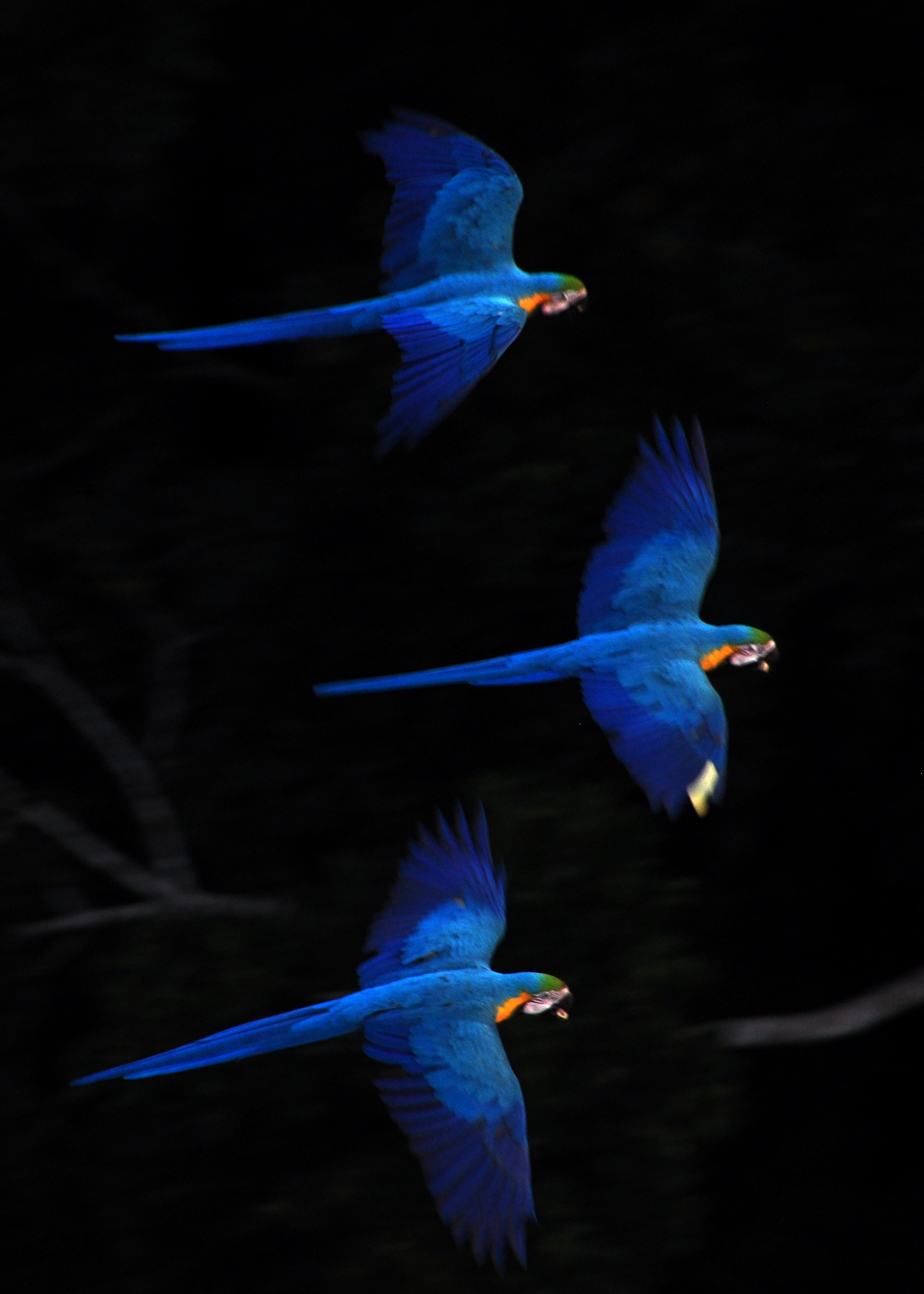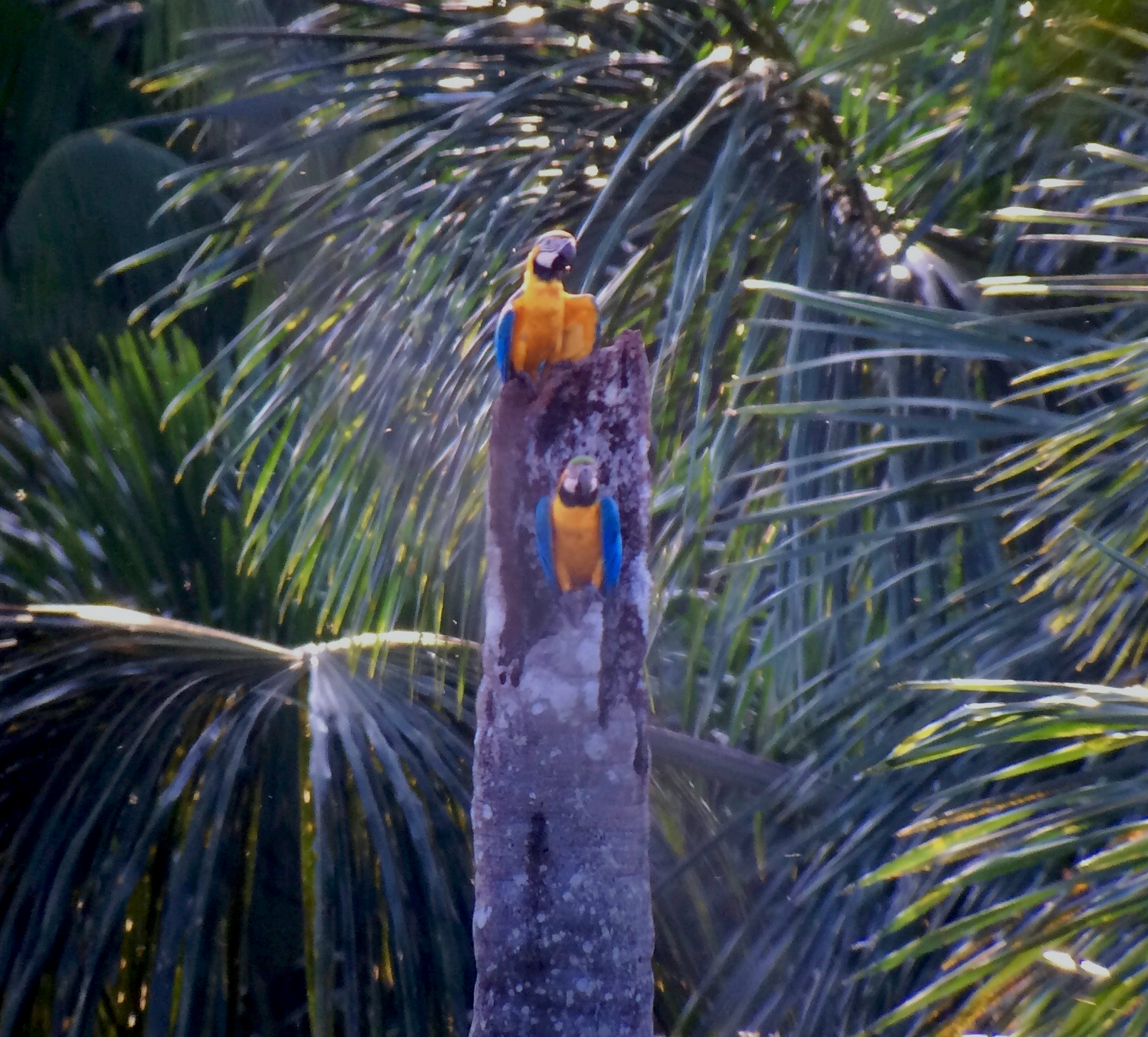Palm swamps: Home sweet home for the blue and yellow macaws!
February 2, 2018
The majesty of Amazonian blue skies and the guardians of the forest have one name and it is: macaws. Their bright colorful plumage and strenuous calls bring harmony to Los Amigos landscape and are a pure delight to the human eyes. Unfortunately, these are the same characteristics that make them highly threatened by pet trade, in addition to the increased rates of habitat degradation and deforestation in the Amazon. Locations where birdwatchers, naturalists, photographers, or any environmental enthusiast can admire these stunning creatures are not many, but in ‘collpas’ or clay licks in southeastern Peru several macaws’ species can display their beauty while feeding. The collpas are locations where animals consume soil, and there are various hypotheses that explain soil consumption such as: mineral supplementation, adsorption of dietary toxins, and mechanical aid to digestion, among others.

Blue-and-yellow (Ara ararauna) macaws, one of the seven species of macaws at Los Amigos, rather than being large frequenters of clay licks are highly associated with palm swamps. However, these brightly colored birds are not attracted to just palm swamp but with the Mauritia flexuosa palm, locally known as “aguajal.” Interestingly, palm fruit is not the main reason why blue-and-yellow macaws are closely tied to this plant, instead their nesting preferences is what makes these palm swamps so appealing. Mauritia flexuosa occurs in monospecific stands, growing in mostly swampy areas. The palm’s height reaches up to 30 m and 30-60 cm in diameter, only the female individuals produce around 500 fruits every season, which are consumed by a variety of animals –including macaws- and have a social and economic importance throughout the Peruvian Amazon. Unfortunately, current harvesting techniques of the “aguaje” are decimating their population, as the female palm is chopped down in order to obtain the edible fruits.
Like most large macaw species, A. ararauna has a low reproductive rate and their reproductive behavior may be affected by the lack of appropriate nesting sites in their natural environment. Blue-and-yellow macaws nest almost exclusively in hollow and dead M. flexuosa palms, at height of approximately 15 meters. After a palm dies, the leafed crowns dry and fall, and the palm heart -located in the trunk’s interior- starts dissecating leaving a hollow trunk with solid walls, creating an ideal nesting site for macaw’s eggs incubation and chicks survival. Certainly, macaws are highly meticulous when finding an appropriate nesting site. Besides finding a dead hollow palm, they have to be isolated from tall surrounding canopy and any other hanging vegetation. In addition, while inside the hollow trunk rotting palm fibers cover the nest floor. These palm characteristics of being a hollow and dead palm that is isolated from surrounding vegetation, is doubtless a good strategy to avoid predation from voracious raptors and arboreal organisms.
 A study conducted in Madre de Dios analyzed the advantages of managing M. flexuosa palm swamps to protect the nesting ecology and population of blue-and-yellow macaws. This was done in a small section of a palm swamp by cutting the top of the palms and removing the understory vegetation. Although it might seem like a drastic management tool, the study reported that cut palms persisted from 4 to 7 years, and were occupied by macaws’ nest at a rate of 24%! From this data, authors suggested that cutting 5 palms annually will generate areas of ~20 dead palms that could be used by 6 or more pairs of macaws every year, thus increasing the reproductive success of blue-and-yellow macaws. This could also be used for ecotourism purposes. In fact, Los Amigos has M. flexuosa palm swamps where blue-and-yellow macaws thrive together with scarlet and red-and-green macaws! The protection of this habitat is vital for their survival, and reminds us how amazing and enchanting the Amazon rainforest is, and how connected every organism is with this immense forest.
A study conducted in Madre de Dios analyzed the advantages of managing M. flexuosa palm swamps to protect the nesting ecology and population of blue-and-yellow macaws. This was done in a small section of a palm swamp by cutting the top of the palms and removing the understory vegetation. Although it might seem like a drastic management tool, the study reported that cut palms persisted from 4 to 7 years, and were occupied by macaws’ nest at a rate of 24%! From this data, authors suggested that cutting 5 palms annually will generate areas of ~20 dead palms that could be used by 6 or more pairs of macaws every year, thus increasing the reproductive success of blue-and-yellow macaws. This could also be used for ecotourism purposes. In fact, Los Amigos has M. flexuosa palm swamps where blue-and-yellow macaws thrive together with scarlet and red-and-green macaws! The protection of this habitat is vital for their survival, and reminds us how amazing and enchanting the Amazon rainforest is, and how connected every organism is with this immense forest.
For further reference:
Brightsmith, D., & Bravo, A. 2006. Ecology and management of nesting blue-and-yellow macaws (Ara ararauna) in Mauritia palm swamps. Biodiversity and Conservation, 15: 4271-4287.

